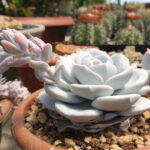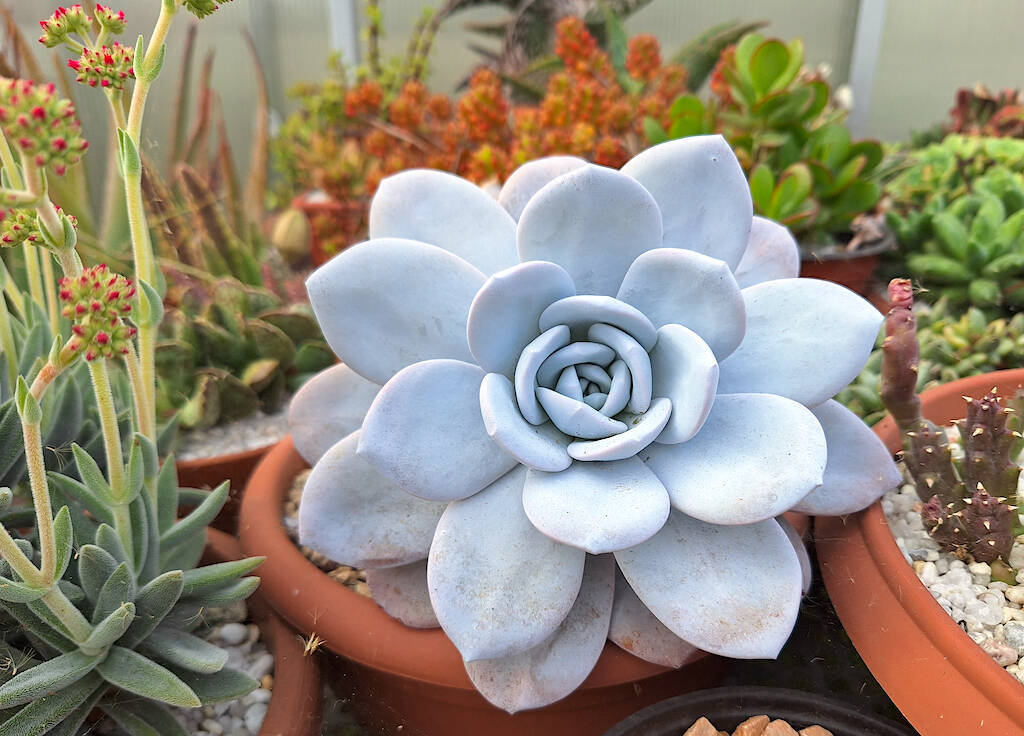Admire it as long as you want, but don’t you dare touch it! Even a simple caress is able to disfigure this masterpiece of Nature, altering the suggestion of wax – or the sensation of painting – that this succulent plant returns to the eye. Echeveria laui is a very widespread Crassulacea and also appreciated by those who mainly grow cacti. Its appearance, on the other hand, is undeniably attractive and it is difficult for a specimen of this succulent to go unnoticed. Either for that splendid blue color, or for the compact shape of the rosette, with the blunt tips or, again, for its uniqueness even within the Echeveria genus, which also boasts various species with specimens with pale blue leaves. The fact is that it is impossible not to admire the perfection of a well-cultivated (and above all never touched!) specimen of this particular species.
In this article we deepen our knowledge of Echeveria laui, we understand why it has this appearance which is certainly not unique in the world of succulents but undoubtedly peculiar, and we learn how to grow it correctly. (…)
Premise
The Echeveria genus is part of the vast Crassulaceae family, leafy succulents with a variable shape from rosette to small tree. All Echeveria are native to the American continent and in particular to Mexico. Echeveria laui, in particular, is native to the Tomelin Caňon area, in the Mexican state of Oaxaca. The name of the genus was coined by the Swiss botanist Augustin Pyrame de Candolle (1778-1841), who in this way wanted to pay homage to the Mexican artist, botanist and naturalist Atanasio Echeverría y Godoy, to whom we owe a great deal of research (together to other botanists and researchers) on Mexican flora and fauna.
The stem of Echeveria is always rosette-shaped, initially flattened but over time tending to rise slightly in height following the development of the central stem from which the leaves branch out. And already in terms of leaves, the laui species differs from the majority of Echeveria: if generally the rosettes of these plants are made up of elongated leaves that end in a point, those of the laui species are blunt, rounded, almost ovoid, and give the together an even more harmonious and “soft” appearance.
Specifically, E. laui is a species (according to some authors it would actually be a hybrid) described for the first time in 1976. The plant immediately received great favor among nurserymen and collectors precisely because of its unique appearance in Crassulaceae family.
The wax coating
The real peculiarity of the laui species, however, is the massive production of wax coating (“farina” or cuticular wax) which entirely covers the leaves. The farina is nothing other than a wax produced by many succulents and some cacti (an example above all, the genus Copiapoa with the cinerea species), which serves to limit the transpiration of the liquids contained in the stems or leaves and to protect the plant from the sun’s ultraviolet rays. The wax is whitish and it is not it that gives the plant its blue color. As in many Echeveria, in fact, it is the leaves that are blue in colour, in the case of the laui more intense: the strong presence of wax accentuates this color and gives the plant a “waxy” appearance or similar to that would be obtained by painting the rosettes with blue paint (a very different thing from the horrible practice of actually painting the succulents with brightly colored paints to increase their sales!).

In some succulent plants – for example Copiapoa – the wax coating can be compact and resist watering. This is not the case with Echeveria laui: it is enough to touch a leaf with a finger to ruin the homogeneity of the colour. For this reason this plant must be watered from below, by immersion, or by wetting only the soil, avoiding watering from above, like rain. Any treatments with products such as Neem oil, copper oxychloride, etc., carried out by nebulization, should also be avoided. Finally, be careful when repotting, for obvious reasons. The task of flaring and repotting a plant by touching it as little as possible is undoubtedly difficult, but with some precautions it is possible to carry out the operation while limiting the aesthetic damage to a minimum. For example, you can grab the plant at the base, especially if you are dealing with specimens of a certain age, since in this way you can only touch the central stem. Or you can delicately hold the plant by the edges of the basal leaves and then grab the block of soil to place it in the new pot without touching the central part of the plant.
Cultivation

The cultivation of Echeveria is simple and within everyone’s reach and the laui species is no exception (except for what concerns watering and repotting, to be carried out with the precautions described above). Echeveria laui is a robust plant and resists prolonged drought as well as cold very well. Like all Echeveria, it fears water stagnation and should therefore be grown in substrates suitable for cacti or in substrates with 40% peat and 60% inert materials such as pumice, lapillus, gravel. Thanks to the strong presence of wax coating, E. laui resists direct sun well (if gradually accustomed from the end of March) but the ideal is to place it in a place where direct sun is limited to half a day. For the rest, lots of indirect light so that the plant can produce wax coating and maintain its compact appearance.
Watering must be moderate: water from mid-March to the end of October only when the soil is perfectly dry and fertilize with a specific product for succulent plants (with low nitrogen content) a couple of times a year.
During the winter, Echeveria should be sheltered from the rain but should not be brought indoors. In fact, these are plants capable of withstanding the cold very well, even up to 2 Celsius degrees above zero, with sporadic peaks at zero degrees. It is essential that the soil is dry from the end of October and that the plant has as much air as possible available. In the cold, the blue rosettes of E. laui can take on beautiful pink shades.
Where to place succulents in winter? Two very useful handbooks.
The growth times of this species are rather slow. The young plants grow relatively quickly in the first two or three years, then they slow down and it takes six to seven years to have rosettes of at least ten centimeters in diameter (the largest specimens can reach 15 centimeters in diameter).
Flowering
The flowering of E. laui is not dissimilar to those of other Echeveria species: the floral stem, up to 30 centimeters long in adult specimens, develops in late spring and between the end of spring and summer. It emerges from the center of the rosette (although in some cases there may be multiple stems, one from the center and others from the sides of the rosette), grows in height and then takes on an arched shape. The actual yellow and orange flowers form from the stem, protected by thick, fleshy bracts.
Propagation

The propagation of this wonderful succulent takes place in spring and can be done through sowing or, more simply, by leaf cutting, as for any other species of Echeveria. It is sufficient to remove a well-formed leaf, let it dry for at least a week in a shaded place so that the “callus” forms on the part detached from the mother plant, and then place the leaf on sand or even peat with a few inerts (pumice, perlite). For the first few weeks you will not have to water but it will be sufficient to mist often. Over the course of a few weeks, roots or new, tiny leaves will begin to emerge from the attachment of the leaf to the rosette. For the first few months we proceed with frequent nebulizations and when the new plant begins to be characterized and equipped with roots we can proceed with the first repotting.
Adversity
Robust plants, Echeveria fear two things more than anything else: water stagnation, which leads to root rot, and cochineal. A common enemy of all succulents, cochineal can be cottony or radical. The first forms white tufts that nestle among the leaves, near the central stem; the second is decidedly more insidious since it hides in the roots and its presence is only noticed when repotting or, unfortunately, when it is too late and the plant shows signs of suffering such as the wilting of the leaves, often followed by induced rot from the weakening of the plant caused by cochineal.
To find out more about succulent parasites, learn to recognize them and intervene when necessary, you can read this article. Other articles on parasites and diseases of succulent plants are collected in this section of the site.
SUBSCRIBE TO THE SITE – If you liked this article, subscribe to the site to have access to all the contents for one year or three months depending on the formula you choose. Here you will find terms and conditions.
SUBSCRIBE TO THE NEWSLETTER – If you want to receive the free newsletter every time new content is published (even if you have not subscribed to the site), fill in the fields at this link!
Correlated articles
- Succulents
- Plant of the day
- Differences between cacti and succulents
- Inert and materials
- Repotting: all the articles
© The texts, videos, photos and graphic elaborations of the site “Il fiore tra le spine” are original material and are covered by copyright. It’s forbidden to reproduce them in any way.



